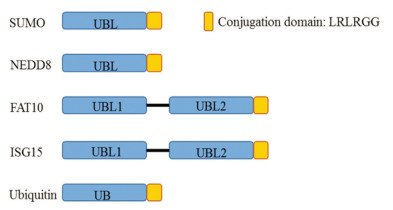-
摘要: 类泛素蛋白是一类与泛素有类似空间结构及酶修饰系统的蛋白质,它们在调节蛋白质功能中发挥着重要作用。类泛素蛋白主要通过对底物蛋白进行类泛素化修饰而发挥核质转运、转录调节、稳定蛋白质、应激反应以及细胞周期调控等多种生物学功能。近年来有大量的研究表明类泛素蛋白功能失调与肝癌的发生、增殖、凋亡以及血管新生等过程密切相关;并且在抗肿瘤药物的研究中也发现,通过调控类泛素化修饰过程可以改变化疗药物的抗肿瘤作用,进而影响肝癌的化疗敏感性,这表明类泛素蛋白可能成为一个新的肿瘤防治靶点。探究类泛素蛋白在肝癌发生、发展中的作用机制对诊断和治疗肝癌有着重要作用。
-
关键词:
- 泛素相关小修饰蛋白 /
- 神经前体细胞表达发育调控蛋白8 /
- 干扰素刺激基因15 /
- 双泛素 /
- 肝癌
Abstract: Ubiquitin-like proteins are structurally similar to ubiquitin. These proteins are processed, activated, conjugated, and released from conjugates by enzymatic steps that are similar to the corresponding mechanisms for ubiquitin. Ubiquitin-like proteins regulate a wide array of cellular processes through modification processes, such as nuclear-cytosolic transport, transcriptional regulation, protein stability, response to stress, and progression through the cell cycle. A large number of recent studies have found dysfunctional ubiquitin-like proteins in hepatocellular carcinoma. These proteins are important in tumorigenesis, cell proliferation, apoptosis, and angiogenesis. Anticancer drug studies revealed that regulating protein modification by using ubiquitin-like proteins may alter the anti-tumor effects of chemotherapy and thus influence the chemosensitivity of hepatocellular carcinoma. Results indicate that ubiquitin-like proteins may become a new target for cancer therapy. The mechanism of ubiquitin-like proteins in tumorigenesis and hepatocellular carcinoma progression is of great significance in the diagnosis and treatment of hepatocellular carcinoma.-
Key words:
- SUMO /
- NEDD8 /
- ISG15 /
- FAT10 /
- hepatocellular carcinoma
-
表 1 SUMO,NEDD8,FAT10,ISG15与泛素的差异
Table 1. Difference between SUMO, NEDD8, FAT10, ISG15, and Ubiq⁃ uitin

-
[1] Chung KY, Cheng IK, Ching AK, et al. Block of proliferation 1 (BOP1) plays an oncogenic role in hepatocellular carcinoma by pro moting epithelial-to-mesenchymal transition[J]. Hepatology, 2011, 54(1):307-318. http://europepmc.org/abstract/MED/21520196 [2] Marrero JA. Multidisciplinary management of hepatocellular carci noma: where are we today?[J]. Semin Liver Dis, 2013, 33(Suppl 1): S3-S10. http://europepmc.org/abstract/med/23769756 [3] Da SS, Paiva SL, Lukkarila JL, et al. Exploring a new frontier in cancer treatment: targeting the ubiquitin and ubiquitin-like activat ing enzymes[J]. J Med Chem, 2013, 56(6):2165-2177. doi: 10.1021/jm301420b [4] Herrmann J, Lerman LO, Lerman A. Ubiquitin and ubiquitin-like proteins in protein regulation[J]. Circ Res, 2007, 100(9):1276-1291. doi: 10.1161/01.RES.0000264500.11888.f0 [5] Zhao Y, Brickner JR, Majid MC, et al. Crosstalk between ubiquitin and other post-translational modifications on chromatin during double-strand break repair[J]. Trends Cell Biol, 2014, 24(7): 426-434. doi: 10.1016/j.tcb.2014.01.005 [6] van der Veen AG, Ploegh HL. Ubiquitin-like proteins[J]. Annu Rev Biochem, 2012, 81:323-357. doi: 10.1146/annurev-biochem-093010-153308 [7] Hochstrasser M. Origin and function of ubiquitin-like proteins[J]. Nature, 2009, 458(7237):422-429. doi: 10.1038/nature07958 [8] Vertegaal AC. Uncovering ubiquitin and ubiquitin-like signaling networks[J]. Chem Rev, 2011, 111(12):7923-7940. doi: 10.1021/cr200187e [9] Forner A, Llovet JM, Bruix J. Hepatocellular carcinoma[J]. Lancet, 2012, 379(9822):1245-1255. doi: 10.1016/S0140-6736(11)61347-0 [10] Yuen MF, Hou JL, Chutaputti A. Hepatocellular carcinoma in the Asia pacific region[J]. J Gastroenterol Hepatol, 2009, 24(3):346-353. http://onlinelibrary.wiley.com/resolve/reference/PMED?id=19095497 [11] Sherman M. Hepatocellular carcinoma: epidemiology, surveillance, and diagnosis[J]. Semin Liver Dis, 2010, 30(1):3-16. http://gut.bmj.com/lookup/external-ref?access_num=10.1055/s-0030-1247128&link_type=DOI [12] Wilkinson KA, Henley JM. Mechanisms, regulation and consequences of protein SUMOylation[J]. Biochem J, 2010, 428(2):133-145. http://www.ncbi.nlm.nih.gov/pmc/articles/PMC3310159/ [13] Cubenas-Potts C, Matunis MJ. SUMO: a multifaceted modifier of chromatin structure and function[J]. Dev Cell, 2013, 24(1):1-12. doi: 10.1016/j.devcel.2012.11.020 [14] Guo WH, Yuan LH, Xiao ZH, et al. Overexpression of SUMO-1 in hepatocellular carcinoma: a latent target for diagnosis and thera py of hepatoma[J]. J Cancer Res Clin Oncol, 2011, 137(3):533-541. doi: 10.1007/s00432-010-0920-x [15] Tomasi ML, Tomasi I, Ramani K, et al. S-adenosyl methionine reg ulates ubiquitin-conjugating enzyme 9 protein expression and su moylation in murine liver and human cancers[J]. Hepatology, 2012, 56(3):982-993. doi: 10.1002/hep.25701 [16] Shen HJ, Zhu HY, Yang C, et al. SENP2 regulates hepatocellular carcinoma cell growth by modulating the stability of beta-catenin [J]. Asian Pac J Cancer Prev, 2012, 13(8):3583-3587. doi: 10.7314/APJCP.2012.13.8.3583 [17] Watson IR, Irwin MS, Ohh M. NEDD8 pathways in cancer, Sine Quibus Non[J]. Cancer Cell, 2011, 19(2):168-176. doi: 10.1016/j.ccr.2011.01.002 [18] Russell RC, Ohh M. NEDD8 acts as a 'molecular switch' defining the functional selectivity of VHL[J]. EMBO Rep, 2008, 9(5):486-491. doi: 10.1038/embor.2008.19 [19] Xirodimas DP, Saville MK, Bourdon JC, et al. Mdm2-mediated NEDD8 conjugation of p53 inhibits its transcriptional activity[J]. Cell, 2004, 118(1):83-97. http://europepmc.org/abstract/MED/15242646 [20] Embade N, Fernandez-Ramos D, Varela-Rey M, et al. Murine double minute 2 regulates Hu antigen R stability in human liver and colon cancer through NEDDylation[J]. Hepatology, 2012, 55 (4):1237-1248. doi: 10.1002/hep.24795/full [21] Wang H, Zeng F, Liu Q, et al. The structure of the ARE-binding domains of Hu antigen R (HuR) undergoes conformational chang es during RNA binding[J]. Acta Crystallogr D Biol Crystallogr, 2013, 69(Pt 3):373-380. http://europepmc.org/abstract/med/23519412 [22] Schmidtke G, Aichem A, Groettrup M. FAT10ylation as a signal for proteasomal degradation[J]. Biochim Biophys Acta, 2014, 1843(1): 97-102. http://europepmc.org/abstract/MED/23333871 [23] Ren J, Wang Y, Gao Y, et al. FAT10 mediates the effect of TNF-al pha in inducing chromosomal instability[J]. J Cell Sci, 2011, 124(Pt 21):3665-3675. doi: 10.1242/jcs.087403 [24] Lee CG, Ren J, Cheong IS, et al. Expression of the FAT10 gene is highly upregulated in hepatocellular carcinoma and other gastroin testinal and gynecological cancers[J]. Oncogene, 2003, 22(17): 2592-2603. doi: 10.1038/sj.onc.1206337 [25] Bardag-Gorce F, Oliva J, Li J, et al. SAMe prevents the induction of the immunoproteasome and preserves the 26S proteasome in the DDC-induced MDB mouse model[J]. Exp Mol Pathol, 2010, 88(3): 353-362. http://med.wanfangdata.com.cn/Paper/Detail?id=PeriodicalPaper_JJ0216306865 [26] Oliva J, Bardag-Gorce F, French BA, et al. Fat10 is an epigenetic marker for liver preneoplasia in a drug-primed mouse model of tu morigenesis[J]. Exp Mol Pathol, 2008, 84(2):102-112. http://pubmedcentralcanada.ca/pmcc/articles/PMC2874461/ [27] Yuan R, Jiang C, Hong K, et al. Genetic variation in the Fat10 gene is associated with risk of hepatocellular carcinoma in a Chinese pop ulation[J]. Asian Pac J Cancer Prev, 2011, 12(8):2117-2122. https://www.researchgate.net/publication/220955091_A_Data_Mining_Approach_for_the_Detection_of_High-Risk_Breast_Cancer_Groups [28] Yu X, Liu X, Liu T, et al. Identification of a novel binding protein of FAT10: eukaryotic translation elongation factor 1A1[J]. Dig Dis Sci, 2012, 57(9):2347-2354. doi: 10.1007/s10620-012-2189-1 [29] Liu L, Dong Z, Liang J, et al. As an independent prognostic factor, FAT10 promotes hepatitis B virus-related hepatocellular carcino ma progression via Akt/GSK3beta pathway[J]. Oncogene, 2014, 33 (7):909-920. doi: 10.1038/onc.2013.236 [30] Sgorbissa A, Brancolini C. IFNs, ISGylation and cancer: Cui prodest [J]. Cytokine Growth Factor Rev, 2012, 23(6):307-314. doi: 10.1016/j.cytogfr.2012.07.003 [31] Andersen JB, Hassel BA. The interferon regulated ubiquitin-like protein, ISG15, in tumorigenesis: friend or foe[J]. Cytokine Growth Factor Rev, 2006, 17(6):411-421. doi: 10.1016/j.cytogfr.2006.10.001 [32] Jeon YJ, Jo MG, Yoo HM, et al. Chemosensitivity is controlled by p63 modification with ubiquitin-like protein ISG15[J]. J Clin In vest, 2012, 122(7):2622-2636. http://pubmedcentralcanada.ca/pmcc/articles/PMC3386819/ [33] Tessema M, Yingling CM, Thomas CL, et al. SULF2 methylation is prognostic for lung cancer survival and increases sensitivity to topoisomerase-I inhibitors via induction of ISG15[J]. Oncogene, 2012, 31(37):4107-4116. doi: 10.1038/onc.2011.577 [34] Kim JH, Luo JK, Zhang DE. The level of hepatitis B virus replica tion is not affected by protein ISG15 modification but is reduced by inhibition of UBP43 (USP18) expression[J]. J Immunol, 2008, 181 (9):6467-6472. doi: 10.4049/jimmunol.181.9.6467 [35] Kanwal F, Kramer JR, Ilyas J, et al. HCV Genotype 3 is Associated with an Increased Risk of Cirrhosis and Hepatocellular Cancer in a National Sample of U.S. Veterans with HCV[J]. Hepatology, 2014, 60(1):98-105. doi: 10.1002/hep.27095 [36] Broering R, Zhang X, Kottilil S, et al. The interferon stimulated gene 15 functions as a proviral factor for the hepatitis C virus and as a regulator of the IFN response[J]. Gut, 2010, 59(8):1111-1119. doi: 10.1136/gut.2009.195545 [37] Konishi H, Shirabe K, Yoshiya S, et al. Hepatic interferon-gam ma-induced protein-10 expression is more strongly associated with liver fibrosis than interleukin-28B single nucleotide polymor phisms in hepatocellular carcinoma resected patients with chronic hepatitis C[J]. Hepatol Res, 2013, 43(11):1139-1147. doi: 10.1111/hepr.12070 [38] Li S, Duan X, Li Y, et al. MicroRNA-130a inhibits HCV replica tion by restoring the innate immune response[J]. J Viral Hepat, 2014, 21(2):121-128. doi: 10.1111/jvh.12131 [39] Finn RS. Emerging targeted strategies in advanced hepatocellular carcinoma[J]. Semin Liver Dis, 2013, 33(Suppl 1):S11-S19. http://europepmc.org/abstract/MED/23457035 [40] Asghar U, Meyer T. Are there opportunities for chemotherapy in the treatment of hepatocellular cancer[J]. J Hepatol, 2012, 56(3): 686-695. doi: 10.1016/j.jhep.2011.07.031 [41] Di Marco V, De Vita F, Koskinas J, et al. Sorafenib: from literature to clinical practice[J]. Ann Oncol, 2013, 24(Suppl 2):i30-i37. http://www.ncbi.nlm.nih.gov/pubmed/23715941 [42] Duffy A, Wilkerson J, Greten TF. Hemorrhagic events in hepatocel lular carcinoma patients treated with antiangiogenic therapies[J]. Hepatology, 2013, 57(3):1068-1077. doi: 10.1002/hep.26120 [43] 李慧锴, 李强.肝癌多药耐药机制研究进展[J].中国肿瘤临床, 2013, (16): 1008-1010.Huikai Li, Qiang Li. Mechanisms of Multidrug-resistance in hepato cellular carcinoma[J]. Chin J Clin Oncol, 2013, (16):1008-1010. [44] Qin Y, Bao H, Pan Y, et al. SUMOylation alterations are associated with multidrug resistance in hepatocellular carcinoma[J]. Mol Med Rep, 2014, 9(3):877-881. http://europepmc.org/abstract/med/24399357 [45] Li J, Xu Y, Long XD, et al. Cbx4 governs HIF-1alpha to potentiate angiogenesis of hepatocellular carcinoma by its SUMO E3 ligase ac tivity[J]. Cancer Cell, 2014, 25(1):118-131. doi: 10.1016/j.ccr.2013.12.008 [46] Qian J, Luo Y, Gu X, et al. Inhibition of SENP6-induced radiosensi tization of human hepatocellular carcinoma cells by blocking radia tion-induced NF-kappaB activation[J]. Cancer Biother Radio pharm, 2013, 28(3):196-200. http://smartsearch.nstl.gov.cn/paper_detail.html?id=fee821e2602bc92c0809d8b09704bdb0 [47] Blank JL, Liu XJ, Cosmopoulos K, et al. Novel DNA damage check points mediating cell death induced by the NEDD8-activating en zyme inhibitor MLN4924[J]. Cancer Res, 2013, 73(1):225-234. doi: 10.1158/0008-5472.CAN-12-1729 [48] Nawrocki ST, Griffin P, Kelly KR, et al. MLN4924: a novel first-in-class inhibitor of NEDD8-activating enzyme for cancer therapy[J]. Expert Opin Investig Drugs, 2012, 21(10):1563-1573. doi: 10.1517/13543784.2012.707192 [49] Luo Z, Yu G, Lee HW, et al. The Nedd8-activating enzyme inhibi tor MLN4924 induces autophagy and apoptosis to suppress liver cancer cell growth[J]. Cancer Res, 2012, 72(13):3360-3371. doi: 10.1158/0008-5472.CAN-12-0388 -




 下载:
下载:



